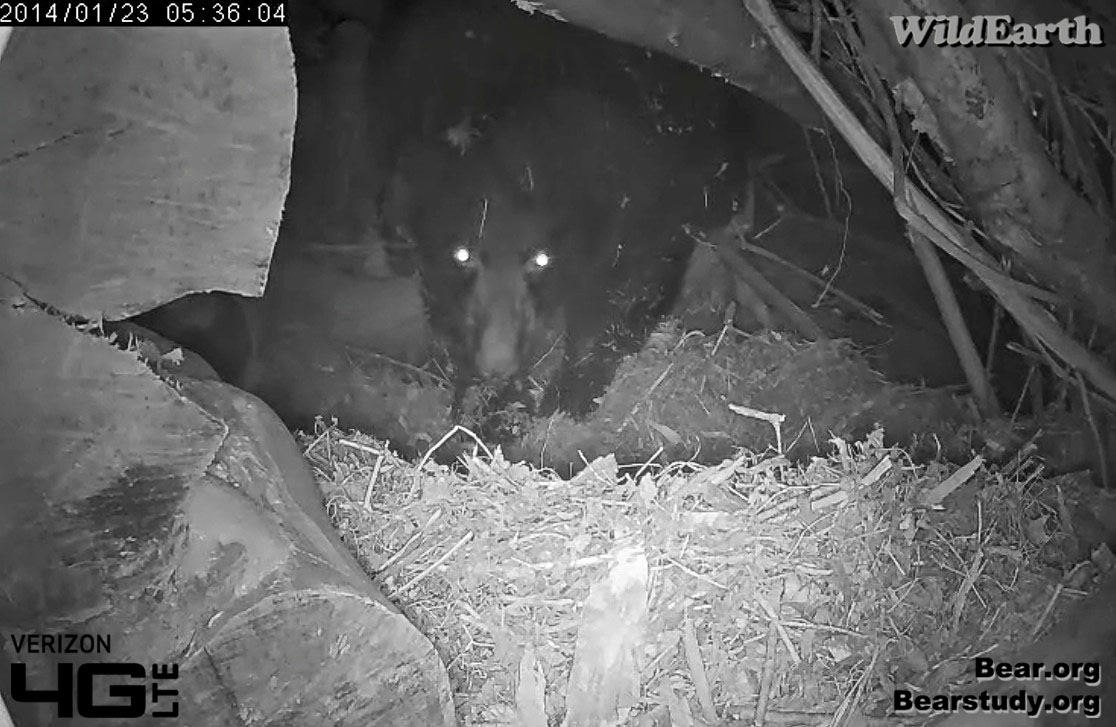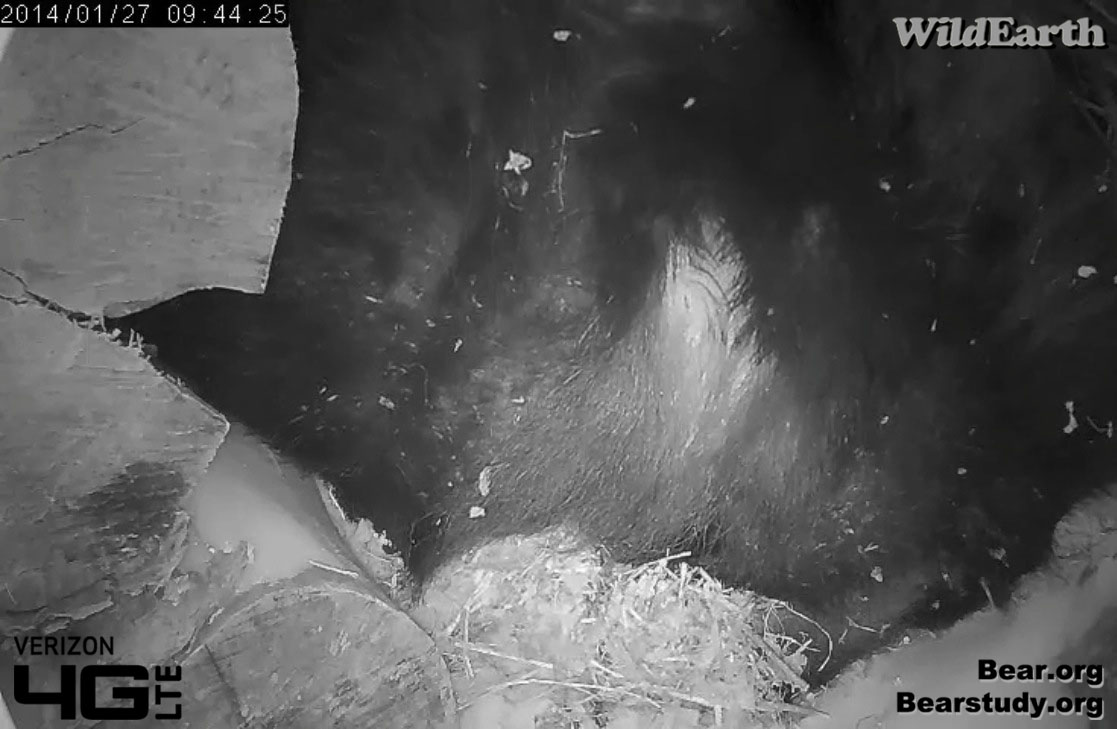Information From Near and Far – UPDATE January 27, 2014
 Juliet backing out of bed - Jan 23 When we heard Lily, Jewel, and now Juliet licking the remainder of the amniotic sac from each newborn cub, we couldn’t see what was happening. A BBC video clip on YouTube shows a captive polar bear doing exactly that http://youtu.be/FhsKUKFctCw. Nice to see.
Juliet backing out of bed - Jan 23 When we heard Lily, Jewel, and now Juliet licking the remainder of the amniotic sac from each newborn cub, we couldn’t see what was happening. A BBC video clip on YouTube shows a captive polar bear doing exactly that http://youtu.be/FhsKUKFctCw. Nice to see.
Another thing we have wondered about is what is happening when the Den Cam bears back out of their beds and appear to be eliminating wastes. We know the usual statement that bears don’t urinate or defecate for months at a time. We have all seen the bears back into what appear to be latrine areas and eliminate, though. But we wondered how much was defecation and how much urination. This year, Juliet is showing us. Earlier, she had backed away from the camera where we couldn’t see. Now, she is backing toward the camera so there’s no doubt. We are seeing that it can be urination or defecation or both. Where does it all come from? That’s another question.
 Juliet backing out of bed to urinateWe don’t often see cubs when they are very young, especially on cold days like today that started at minus 24F and is now minus 17F. But a rehabber who is watching a mother bear and her newborn cub does. The mother is a free-roaming bear most of the year. She gave birth to a single cub on January 4. He sent this picture of her cub taken January 27 and the story of how he got it. By comparison, Juliet’s cubs are 4 days old.
Juliet backing out of bed to urinateWe don’t often see cubs when they are very young, especially on cold days like today that started at minus 24F and is now minus 17F. But a rehabber who is watching a mother bear and her newborn cub does. The mother is a free-roaming bear most of the year. She gave birth to a single cub on January 4. He sent this picture of her cub taken January 27 and the story of how he got it. By comparison, Juliet’s cubs are 4 days old.
He wrote: “For some reason the temperature this morning was 40F. I took this opportunity to check on Rose’s cub. Rose has not been out of the den for over a week, not even to urinate. I took her a snack and some water. She came out talking to me and I crawled in with the cub; such a healthy little boy. At one point I took the cub completely out to Rose’s surprise. She quickly came over to me and very gently took the cub from my hand with her mouth and put it back in the den. She then finished her snack and urinated before attending the cub again. “
 Rose's cubThe mother coming over to gently take the cub reminded Lynn of when he introduced little orphaned Gerry to a foster mother in April 1989 and the scared cub ran to an Italian cameraman and climbed his leg. The mother came over and gently peeled Gerry off the man’s leg as the man’s eyes grew large and he said something in Italian. The mother accepted Gerry as one of her own and raised her. The story also reminded Lynn of when Gerry grew up and had her first litter. Lynn took a cub out from under Gerry, and Gerry gently reached with her mouth and carefully placed it under her next to its littermate.
Rose's cubThe mother coming over to gently take the cub reminded Lynn of when he introduced little orphaned Gerry to a foster mother in April 1989 and the scared cub ran to an Italian cameraman and climbed his leg. The mother came over and gently peeled Gerry off the man’s leg as the man’s eyes grew large and he said something in Italian. The mother accepted Gerry as one of her own and raised her. The story also reminded Lynn of when Gerry grew up and had her first litter. Lynn took a cub out from under Gerry, and Gerry gently reached with her mouth and carefully placed it under her next to its littermate.
Gerry had no fear of Lynn and responded accordingly. That brings us to a radio interview a Lily Fan alerted us to today at http://www.cbc.ca/thecurrent/episode/2013/05/14/why-we-need-to-get-over-our-fear-of-bears. It’s a CBC interview of Charlie Russell and former Superintendent of Banff National Park Kevin Van Tighem, author of the new book “Bears Without Fear.” The gist of the interview was how bear management has changed in Canadian National Parks. The goal used to be to make bears and people afraid of each other. They shot rubber bullets at bears and scared people with warnings about bears. Now, they teach people about bears and allow bears to become comfortable with people. As Charlie Russell has also been saying, Kevin said it makes bears and people safer. Now, when a bear learns that good grass grows beside a road and learns that people are not a danger, the park doesn’t hurt or kill the bear, they manage the people. They keep people on the road so the bear can eat in peace and ignore the people.
That is also the approach Lynn’s former employee, now in charge of bear management in Yellowstone National Park, takes with roadside grizzlies without a problem.
Lily Fans will find that kind of thinking familiar.
Thank you for all you do.
—Lynn Rogers and Sue Mansfield, Biologists, Wildlife Research Institute and North American Bear Center
All photos taken today unless otherwise noted.
